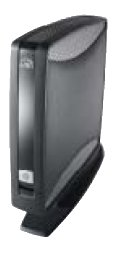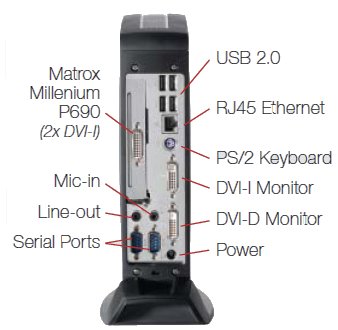Five “universal” thin clients run Linux
Jan 29, 2009 — by LinuxDevices Staff — from the LinuxDevices Archive — 42 views Igel has announced five new thin clients that run Linux, using Via or AMD processors. The new UD2, UD3, UD5, UD7, and UD9 (left) offer a variety of form factors, as well as “Digital Service Pack” software that can simply thin-client configuration, says the company.
Igel has announced five new thin clients that run Linux, using Via or AMD processors. The new UD2, UD3, UD5, UD7, and UD9 (left) offer a variety of form factors, as well as “Digital Service Pack” software that can simply thin-client configuration, says the company.
(Click here for a larger view of Igel's UD2, UD3, UD5, UD7, and UD9)
Igel's five new UD (“universal desktop”) thin clients come in four different form factors, with a choice of Via Eden, C7, or AMD Sempron processors. In many ways, however, it's the software that is of greater interest. First, in addition to supporting the company's own Igel Linux implementation, the thin devices run Microsoft's new Windows Embedded Standard (WES) 2009 operating system. Second, Igel is apparently making an effort to mitigate the confusion facing buyers of today's thin clients, which tend to be offered with a bewildering variety of software options. Its new range of thin clients is being offered with three “Digital Service Packs,” in “Entry,” “Standard,” and “Advanced” editions.
Digital Service Pack features are said to include:
- Entry Digital Service Pack:
- Microsoft RDP and Citrix ICA support
- “Entry-level” printing
- A Java runtime environment
- Microsoft RDP and Citrix ICA support
- Standard Digital Service Pack:
- Desktop virtualization support
- A PDF viewer
- “Local media playback” via DSV (digital services virtualization) multimedia
- VPN access and terminal emulation
- “Optimized” printing
- Desktop virtualization support
- Advanced Digital Service Pack:
- Support for DSV
- A special user interface to SAP enterprise software
- Additional “specialist server-based protocols” such as No Machine NX
- USB redirection on Windows Embedded Standard (WES) only, or VoIP (Linux only)
- Support for DSV
There's still some fine print attached to all this. For example, buyers choosing the Entry Digital Service pack on Windows CE thin clients don't get the Java runtime environment. The Advanced Digital Service Pack adds USB redirection only on one underlying OS (WES), and VoIP only on another (Linux). And, the Advanced Digital Service Pack isn't available for Windows CE devices at all.
Still, we'd say that all in all, Igel's tiered software offerings do add a welcome dollop of clarity. So now, on to the new hardware.


Igel's UD2 (l) and UD3/5/7
UD2
Igel's new UD2 is positioned as a “small, affordable, energy efficient” thin client that supports VESA mounting to the back of a monitor. It comes with a 400MHz Via Eden processor and the chipmaker's CN700 chipset, plus either 512MB or 1GB of RAM, and either 1GB or 2GB of flash storage.
According to Igel, the UD2 has a DVI-I port capable of supporting one digital and one analog monitor via an optional Y-cable. Other ports include 10/100 Ethernet, four USB 2.0 ports, a PS/2 keyboard port, plus a front-panel microphone input and line output.
Measuring 8.1 x 8 x 2.55 inches (208 x 203 x 65mm), the UD2 is said to idle using 13 Watts, and to sleep using just two Watts. The device runs Linux, Windows CE, or WES, and is available with Igel's Entry and Standard Digital Service Packs.
UD3
Igel's UD3 is slightly larger than the UD2, and doubles the Via Eden's processing speed to 800MHz. Again, it comes with 512MB or 1GB of RAM, and either 1GB or 2GB of flash storage.
Featuring the same DVI-I port as the UD2, the device has five USB 2.0 ports (one in the front, four in the rear), a PS/2 port, a serial port, and 10/100 Ethernet. A second serial port is said to be available in an optional “connectivity foot” that also adds WiFi.
Measuring 9.09 x 8.93 x 3.22 inches (231 x 227 x 82mm), the UD3 is said to use 12 Watts while idle, and two watts while sleeping. It runs Linux, Windows CE, or WES, and is offered with all three of Igel's Digital Service Packs — Entry, Standard, and Advanced.
UD5
Igel's UD5 switches to a 1.5GHz Via C7 processor, and also employs Via's CN896 companion chip, from which it gains 2D/3D graphics acceleration, and additional support for dual displays. Like its smaller siblings, the UD5 comes with 512MB or 1GB of RAM, and either 1GB or 2GB of flash storage.
The UD5 measures 10.7 x 9.64 x 4.09 inches (272 x 245 x 104mm), and offers a wider rear panel with an aperture for the included PCI expansion slot. This time out, there are both DVI-I and DVI-D video ports, the former capable of connecting to analog VGA monitors via a bundled adapter.
According to Igel, the UD5 has six USB 2.0 ports (two in front, four in the rear), a gigabit Ethernet port, a PS/2 keyboard ports, line out and mic in audio connectors, and two serial ports. Once again, an optional “connectivity foot” is offered, this time sporting a parallel port and 802.11b/g wireless networking.
For the UD5, Igel oddly didn't specify which of its Digital Service Packs are available. However, the device is offered with either Linux or WES. Power consumption is said to be 18 Watts while idling, and four Watts while sleeping.
UD7
Igel's UD7 uses the same CPU, memory complement, and case as the UD5. However, the otherwise-identical system comes with a Matrox P690 graphics card installed in its PCI expansion slot. Featuring two additional DVI-I ports on a combo connector, the card creates a thin client that can drive up to four displays, each with resolutions of up to 1920 x 1200 pixels, says Igel.

Igel's UD7 includes a Matrox graphics card, for two additional DVI-I ports
Available with an optional smartcard reader, plus the same “connectivity foot” as the UD5, the UD7 comes only with the Advanced Digital Service Pack software, plus either Linux or WES. Power consumption, obviously increased by the add-on graphics card, is said to be 33 Watts while idling, and four Watts in sleep mode.
UD9
 Igel's UD9 is a thin client built into a 19-inch screen, and billed as “ideal for customer-facing situations or space-constrained environments.” The Samsung LCD used in the UD9 is not a touchscreen display, but it delivers 1280 x 1024 resolution. Meanwhile, the UD9 has ports for both VGA-out and VGA-in, so it can not only drive an external display, but can also display output from a laptop or other connected device.
Igel's UD9 is a thin client built into a 19-inch screen, and billed as “ideal for customer-facing situations or space-constrained environments.” The Samsung LCD used in the UD9 is not a touchscreen display, but it delivers 1280 x 1024 resolution. Meanwhile, the UD9 has ports for both VGA-out and VGA-in, so it can not only drive an external display, but can also display output from a laptop or other connected device.
The UD9 uses AMD's Sempron 2100+ CPU, clocked at 1GHz, plus the AMD/ATI RS690M mobile chipset. Like Igel's other thin clients, it includes 512MB or 1GB of RAM, and 1GB or 2GB of flash storage.
Here, there are no “connectivity feet” or expansion options. However, Igel says the UD9 has a gigabit Ethernet port, a mic input, line input, line output, four USB 2.0 ports, plus built-in stereo speakers.
Finally, the UD9 comes only with the Advanced Digital Service Pack, plus either Linux or WES as an operating system. Idle power consumption is 50 Watts, while sleep mode uses just two Watts, according to Igel.
Further information
Igel did not provide pricing or availability information for its new UD2, UD3, UD5, UD7, and UD9 thin clients. More information may be found on the company's website, here.
This article was originally published on LinuxDevices.com and has been donated to the open source community by QuinStreet Inc. Please visit LinuxToday.com for up-to-date news and articles about Linux and open source.